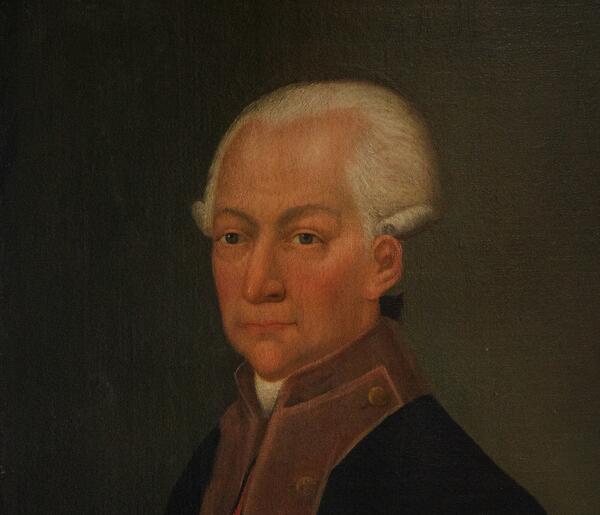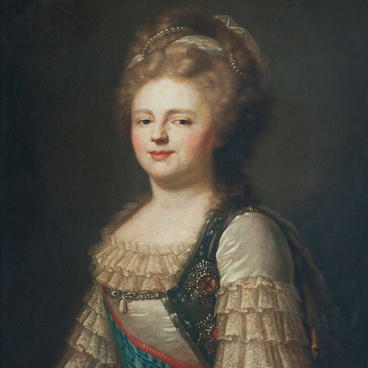This portrait depicts the Governor of Arkhangelsk and Olonets, Ivan Lieven. He was born in 1735 into the family of the Courland szlachta. The word szlachta means ‘nobility’, and Courland was the territory in the west of modern Latvia. In the 18th century, the Courland governorate was part of the Russian Empire.
At the age of 17, Ivan Lieven entered military service. He participated in the Seven Years’ War of 1756–1762, the capture of Berlin and the Russian-Turkish war of 1768—1774.
Lieven ruled Arkhangelsk and the surrounding territories for 18 years. His posts changed together with the monarchs. In 1780, Major General Lieven was appointed Chief Commandant of Arkhangelsk and the ruler of the Arkhangelsk Region. After the provincial reform of Catherine II, when the administrative-territorial division in the country changed, Lieven became the governor of Arkhangelsk — the representative of the emperor. Then he received a higher military rank of lieutenant general.
In 1785, the Empress awarded Lieven with the recently established Order of St. Vladimir, II Class for his impeccable service and military exploits. In 1796, by the decree of Paul I, who succeeded the throne after Catherine II, the Arkhangelsk viceroyalty was abolished, and Arkhangelsk became a provincial city again, and Lieven was appointed military governor. This position was the last in his career. Having received the rank of lieutenant general, and then general of infantry and the order of St. Alexander Nevsky, he resigned, but he lived in Arkhangelsk until the end of his days.
According to Lieven’s contemporaries, he was an intelligent, organized and honest person. Despite the merits, high ranks and titles, he did not own either land or serfs. During his time, in 1786, the first civilian medical institution was opened — the hospital of the Order of Public Charity. In the same year, the first secular general educational institution in the city, the Main Public School, was opened, and a nautical school was transferred from Kholmogory to Arkhangelsk.
The portrait of Ivan Lieven was painted by an unknown provincial artist. Most likely, this was due to the special honors received by those who had the Order of St. Vladimir. It is known that Lieven was awarded in 1785, but he received the order several years later when he was 52 years old.
At the age of 17, Ivan Lieven entered military service. He participated in the Seven Years’ War of 1756–1762, the capture of Berlin and the Russian-Turkish war of 1768—1774.
Lieven ruled Arkhangelsk and the surrounding territories for 18 years. His posts changed together with the monarchs. In 1780, Major General Lieven was appointed Chief Commandant of Arkhangelsk and the ruler of the Arkhangelsk Region. After the provincial reform of Catherine II, when the administrative-territorial division in the country changed, Lieven became the governor of Arkhangelsk — the representative of the emperor. Then he received a higher military rank of lieutenant general.
In 1785, the Empress awarded Lieven with the recently established Order of St. Vladimir, II Class for his impeccable service and military exploits. In 1796, by the decree of Paul I, who succeeded the throne after Catherine II, the Arkhangelsk viceroyalty was abolished, and Arkhangelsk became a provincial city again, and Lieven was appointed military governor. This position was the last in his career. Having received the rank of lieutenant general, and then general of infantry and the order of St. Alexander Nevsky, he resigned, but he lived in Arkhangelsk until the end of his days.
According to Lieven’s contemporaries, he was an intelligent, organized and honest person. Despite the merits, high ranks and titles, he did not own either land or serfs. During his time, in 1786, the first civilian medical institution was opened — the hospital of the Order of Public Charity. In the same year, the first secular general educational institution in the city, the Main Public School, was opened, and a nautical school was transferred from Kholmogory to Arkhangelsk.
The portrait of Ivan Lieven was painted by an unknown provincial artist. Most likely, this was due to the special honors received by those who had the Order of St. Vladimir. It is known that Lieven was awarded in 1785, but he received the order several years later when he was 52 years old.



